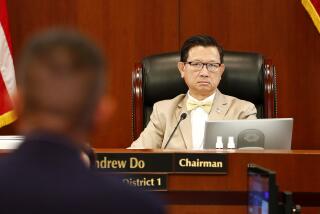Dole Helps Red Cross Mark Century in O.C.
- Share via
As head of an agency that has tracked this winter’s El Nino scourge across the continent, American Red Cross President Elizabeth Hanford Dole said Saturday it will take more organization, fund-raising and volunteers--particularly young people--to address emergencies in the future.
“El Nino has certainly been a problem throughout California and the coastal areas this year,” Dole said in a Newport Beach speech commemorating the 100th anniversary of the Orange County Red Cross chapter. “Here and in Orlando and many other areas we’ve seen the havoc El Nino has played.”
Just in Orange County, the Red Cross spent nearly $100,000 to feed, house and help an estimated 237 families affected by storms and mudslides from November 1997 to this month, Red Cross officials said.
“We really are the first to arrive and the last to leave,” Dole said.
Because of El Nino, Red Cross officials in Orange County have assisted 251 people from 111 families that reported storm-related damage in Seal Beach and Laguna Beach. Nearly 1,400 meals were served, and 90 people were counseled through Red Cross mental health services.
But the luncheon Saturday was intended to celebrate the accomplishments of the Orange County chapter, which Dole hailed for its work on El Nino, for its youth volunteer program and for outreach efforts to Latinos and Asians. The outreach program paid dividends during fund-raising last year for Typhoon Linda in Vietnam.
And it was a chance for Red Cross supporters who paid as much as $500 a plate to meet Dole, the energetic, animated and personable celebrity-politician who has run the agency since 1991--except for a 14-month leave to help her husband, Bob Dole, campaign for president in 1996.
Dole dazzled the audience of 115 at Bistro 201, a stylish Newport Beach restaurant. She wore a wireless, clip-on microphone, leaving her hands free as she spoke and walked unfettered from table to table through the banquet room overlooking Newport Bay.
“Now that I’m back [from the presidential campaign], I can’t talk about politics--except maybe just a little bit,” she said in her gentle North Carolina drawl.
From there, she recounted her first-ever ride on a motorcycle during a 1996 television campaign appearance, telling driver Jay Leno: “Rev it, baby, let’s get out of here.”
“I’ll do anything to help support my husband,” she said.
In a brief interview with The Times, Dole demurred on the question of her own political future, which observers, including her husband, have said could include a White House run as a candidate for president or vice president in 2000.
“No plans to run,” she said with a smile, calling the Red Cross “a mission.”
Admirers in the room Saturday seemed to believe she has what it takes, but they declined to give her advice on a political future.
“She’s inspiring,” said Noddie Weltner, an Irvine event planner and member of the board of directors of the Orange County Red Cross. “She’s certainly a woman of the ‘90s.”
“Wherever she is, she’ll be of benefit,” said Robert Wenzel, chairman of the chapter board and a local attorney.
Dole has overseen what she described as an agency making a transformation from its modern roots as a World War II service organization to a 1990s business.
She conceded the transition has been “wrenching” as dozens of blood labs across the country were forged into eight regional centers. The Red Cross has also spent $287 million to improve blood testing and medical services.
Dole said disaster work is coordinated by a national command center at its Virginia headquarters. The center, staffed around the clock, works to monitor and anticipate conditions that could trigger a need for Red Cross services--earthquakes, hurricanes, tornadoes and other disasters.
“We’re responsible for every inch of American soil,” Dole said.
Red Cross disaster workers learned from events such as Hurricane Andrew in 1992 in the Southeast, where utility service was disrupted for long periods of time.
“You’ve got to have satellite uplink and cellular phones to stay in touch--all of that is warehoused now,” she said.
More to Read
Sign up for Essential California
The most important California stories and recommendations in your inbox every morning.
You may occasionally receive promotional content from the Los Angeles Times.












